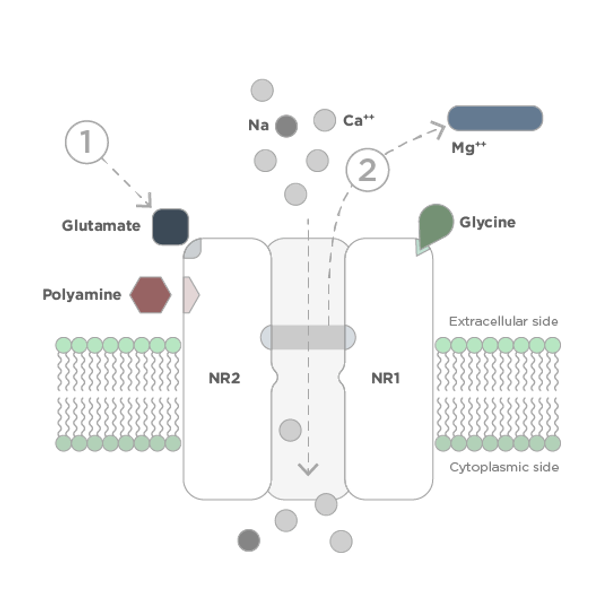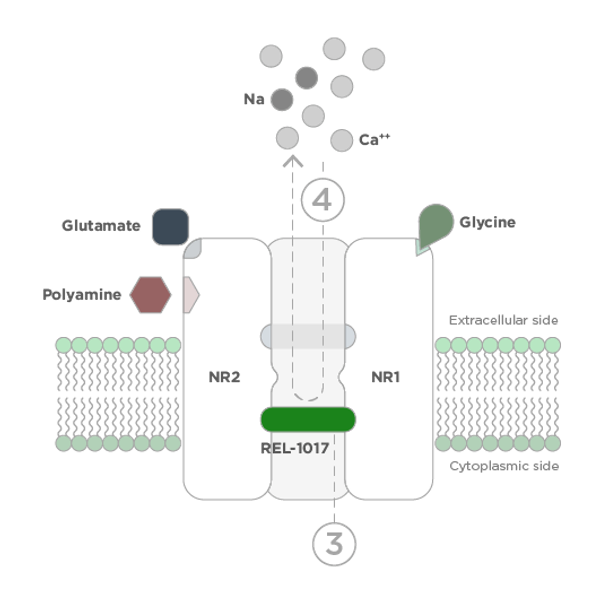

- Home
- Companies
- Relmada Therapeutics, Inc.
- Products
- Novel MOA - Model REL-1017 - Novel ...
Novel MOA - Model REL-1017 - Novel N-methyl-D-Aspartate Receptor (NMDAR) Channel Blocker
Novel MOA: REL-1017 works as an NMDAR channel blocker with preferential activity at hyperactive GluN1-GluN2D channels. REL-1017 is a novel N-methyl-D-aspartate receptor (NMDAR) channel blocker in phase 3 clinical trials for the treatment of Major Depressive Disorder (MDD). REL-1017 works with a MOA markedly different from standard serotoninergic antidepressants.
REL-1017 is thought to work through a selective, preferential block of hyperactive channels that may be associated with MDD.
REL-1017 has been shown to preferentially block hyperactive GluN1-GluN2D NMDARs1. These channels are situated within the membrane of neurons and receive signals via glutamate, a neurotransmitter. NMDA stands for N-methyl-D-aspartate, a chemical able to open the channel similarly to the physiological neurotransmitter glutamate.
NMDARs are known to have a role in depression, as well as in normal physiological functions. Blocking hyperactive NMDAR channels represents a novel approach to rapidly treating depression with a mechanism that is different from standard serotoninergic antidepressants.
REL-1017 works as an NMDA receptor (NMDAR) channel blocker that preferentially targets GluN1-GluN2D hyperactive channels. More specifically, REL-1017 shows preferential blocking of NMDAR subtypes that may be of particular importance in MDD, while avoiding channels with normal physiological functions. REL-1017 appears to provide antidepressant effects without causing psychotomimetic effects typically associated with drugs that work on the same receptors2.
As stated by the US Drug Enforcement Agency (DEA), esmethadone lacks significant respiratory depressant action and addiction liability3. In addition to blocking hyperactive open NMDAR channels, REL-1017 has been shown to potentially increase plasma levels of BDNF in humans4 and induce neural plasticity in animal models of depression5.
Relmada has built a strong intellectual property position around REL-1017, with key patent protections extending into the mid-2030s. The Reliance Clinical Research Program is ongoing, and is designed to evaluate the safety and efficacy of REL-1017 as a treatment for MDD.

(1) Presynaptic release of glutamate causes neuronal membrane depolarization and release of the physiologic magnesium block (2). Sodium and calcium flow into the neuron. Calcium is especially relevant because if the channel remains open too long it can cause functional impairment and even death of the neuron (apoptosis).

(3) REL-1017 enters the NMDAR channel only when the NMDAR channel is hyperactive. By positioning itself in the center of the open channel, REL-1017 effectively blocks the entry of excessive amounts of calcium into the neuron (4).
As soon as excess calcium entry is stopped, the functions of the neuron are re-instituted, including the production of BDNF and synaptic proteins (neural plasticity) 2, potentially restoring neuronal circuits essential for mental health 3.
1) DEA, Drug and Chemical Evaluation Section, Methadone, July 2019.
2) Fogaça MV, Fukumoto K, Franklin T, et al. N-Methyl-D-aspartate receptor antagonist d-methadone produces rapid, mTORC1-dependent antidepressant effects. Neuropsychopharmacology. 2019;44(13):2230–2238.
3) Results from REL-1017 phase 2 trial in MDD
4) De Martin S, Vitolo O, Bernstein G, Alimonti A, et al. The NMDAR Antagonist Dextromethadone Increases Plasma BDNF Levels in Healthy Volunteers Undergoing a 14-Day In-Patient Phase 1 Study. ACNP 57th Annual Meeting: Poster Session II. Neuropsychopharmacol. 43, 228–382 (2018).
